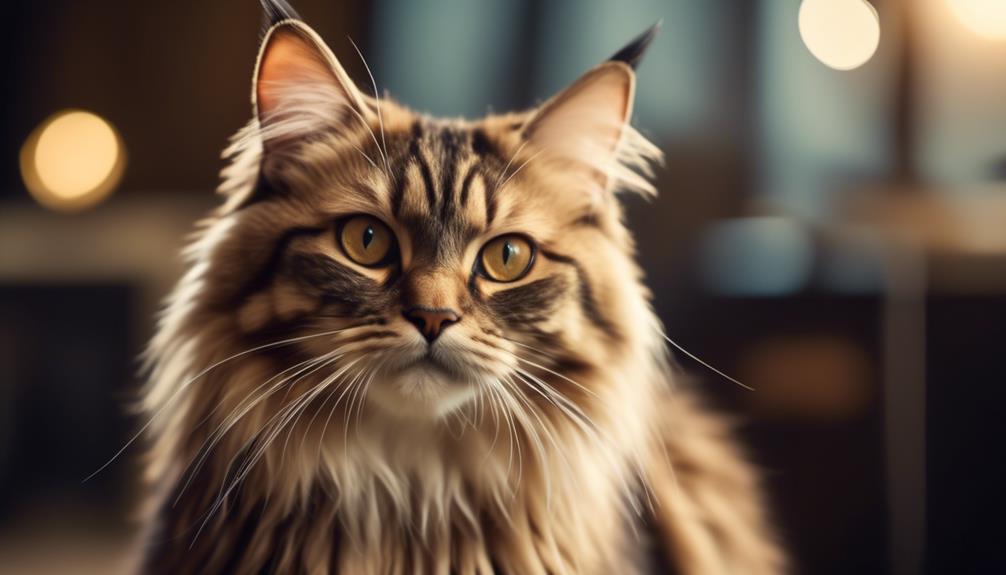
The Cymric cat breed is a fascinating and captivating feline that has caught the attention of cat enthusiasts worldwide.
Originating from the Isle of Man and later bred in Canada, the Cymric is known for its unique characteristic of being tailless or having a short tail.
But there is much more to this breed than its adorable appearance.
In this discussion, we will explore the origin, size, and coat characteristics of the Cymric, as well as its affectionate nature, hunting skills, and intriguing history.
Additionally, we will delve into adoption considerations, care tips, and potential health issues associated with this exceptional breed.
Stay tuned to unravel the secrets of the captivating Cymric cat.
Key Takeaways
- Cymric cats are a medium-sized breed with a long, dense, double-layered coat. They have a lack of tail or a short tail, but it doesn’t hinder their agility.
- Cymric cats are known for being affectionate with their family and have a mellow and loving nature in serene surroundings. They enjoy following their favourite person and can converse with a quiet trill.
- Cymric cats have fine hunting skills and alert nature, making them act as watch cats that react rapidly to anything unusual.
- When adopting a Cymric cat, it is recommended to prioritize rescue organizations or shelters and conduct thorough research to choose a reputable breeder who prioritizes health and temperament. Regular care and health checks are necessary, and unethical breeding practices should be discouraged.
Origin and Size
The Cymric cat breed originated on the Isle of Man and is known for its medium size.
This long-haired breed typically weighs between 8 to 12 pounds. The lack of a tail or a short tail does not hinder its agility.
The Cymric cat has a dense, double-layered coat that requires regular grooming.
In terms of temperament, these cats are affectionate with their families and have fine hunting skills.
They are also known to be mellow and affectionate in serene surroundings, often enjoying following their favourite person.
Cymric cats are also watchful, reacting rapidly to anything unusual.
They tend to vocalize and can carry on a quiet, trill conversation.
The breed’s taillessness results from a natural genetic mutation intensified by their remote location on the Isle of Man.
See another cat breed profile.
Cyprus Cat Breed
Breed Group and Lifespan

Cymric cats belong to the breed group of long-haired cats and typically have a lifespan of 12 to 16 years.
As part of the long-haired breed group, Cymrics have a luxurious, dense, double-layered coat that requires regular grooming.
Despite the absence or shortness of their tails, these cats are highly agile and possess excellent hunting skills.
Known for their alert nature, Cymrics make excellent watchcats, quickly reacting to unusual occurrences.
In serene surroundings, they exhibit a mellow and affectionate demeanour.
They are also known to be happy and playful, often following their favourite person around.
Cymrics tend to vocalize, communicating in a quiet trill and engaging in conversations with their owners. These cats can provide companionship for many years with proper care and attention.
Coat and Tail Characteristics
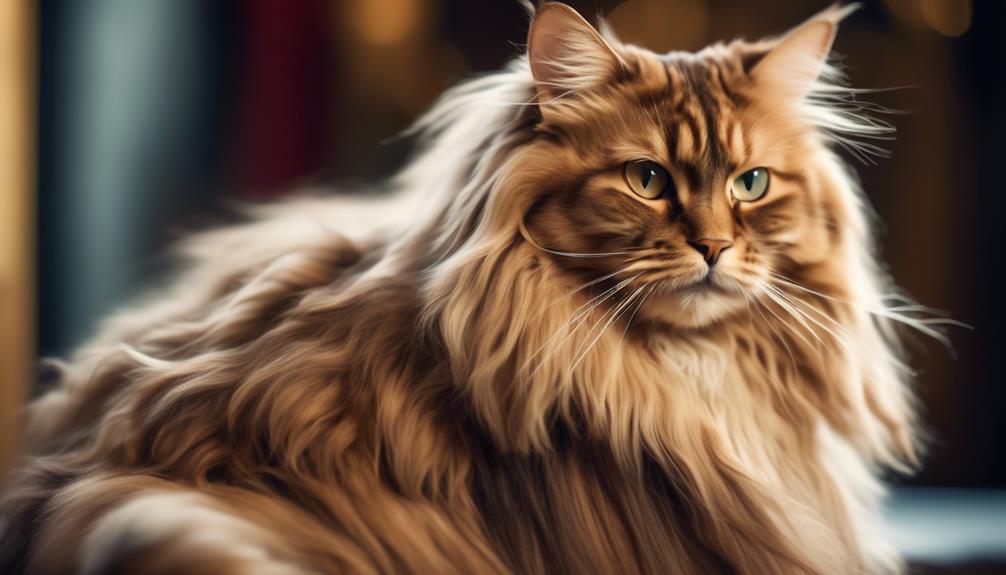
The coat and tail characteristics of the Cymric cat breed are distinct and notable.
Here are some key features to consider:
- Coat: The Cymric has a long, dense, and double-layered coat. It is known for its soft and silky texture. The fur gradually lengthens from the shoulders, with longer fur on the neck, ruff, breeches, and belly. This luxurious coat comes in various colours, adding to the breed’s charm.
- Lack of Tail or Short Tail: The Cymric is specifically bred to be tail-free, although some individuals may have normal or short tails. Surprisingly, this lack of tail or short tail does not hinder their agility. It is a unique characteristic that sets them apart from other cat breeds.
- Coat Care: The Cymric’s coat is easily cared for with regular brushing or combing. This helps to prevent matting and keep the fur in good condition. Additionally, it is important to check and clean the rear end to prevent faeces from clinging to the fur.
- Tailless Watchcat: Despite the absence of a tail, the Cymric acts as a watchcat, reacting rapidly to anything out of the ordinary. They have a round head with large round eyes, a stout and powerful body, and a broad chest.
Their distinct coat and tail characteristics contribute to their overall appeal and uniqueness.
Affectionate and Playful Nature

Moving on to the affectionate and playful nature of the Cymric cat breed, their unique coat and tail characteristics are complemented by their engaging personality.
Cymrics are known for their loving and affectionate nature towards their families.
They enjoy being around their favourite person, often following them around the house.
Despite their mellow and serene demeanour in calm surroundings, Cymrics are also playful and happy.
They tend to engage in interactive play sessions, making them a great companion for those who enjoy interactive playtime with their pets.
Additionally, Cymrics have a unique way of communicating with their trill-like vocalizations, allowing them to carry on conversations with their human companions.
| Trait | Description | Example |
|---|---|---|
| Affectionate | Loving and affectionate towards their families | He enjoys snuggling and being petted |
| Playful | Engages in interactive play sessions | Chases after toys and plays with catnip mice |
| Vocal | Communicates through trill-like vocalizations | Carries on conversations with their human companions |
Vocalization and Hunting Skills
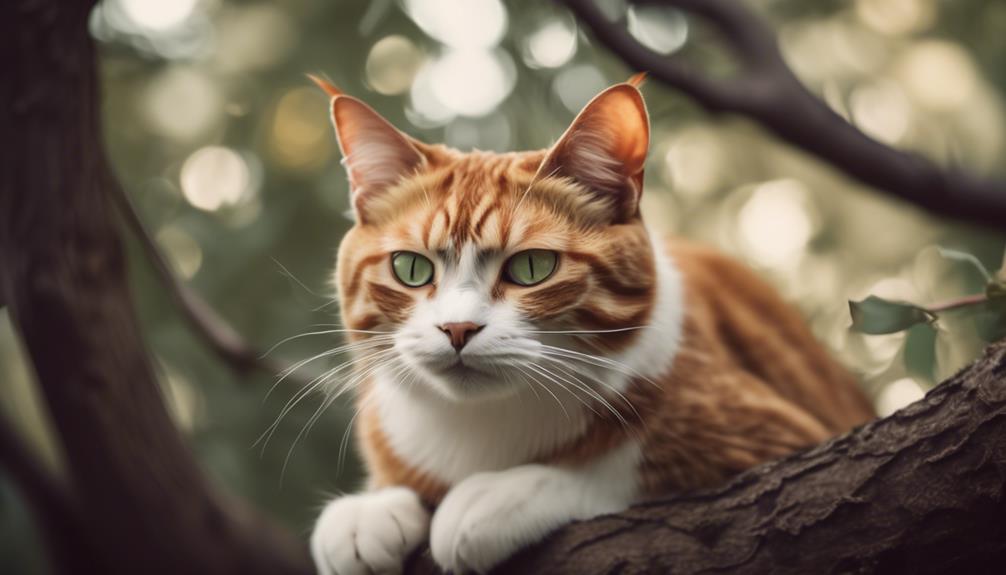
One notable aspect of the Cymric cat breed is their vocalization and fine hunting skills.
These cats are known for their ability to communicate through a quiet trill and can even carry on a conversation with their human companions.
When it comes to hunting, the Cymric is a natural-born predator.
Here are four characteristics that make their hunting skills exceptional:
- Exceptional agility: The Cymric’s lack of tail or short tail doesn’t hinder their ability to manoeuvre and pounce with precision.
- Sharp senses: These cats have keen eyesight and acute hearing, allowing them to detect the slightest movement or sound.
- Patience and stealth: The Cymric exhibits patience and stealth when stalking prey, ensuring a successful hunt.
- Strong hunting instincts: Their alert nature and strong hunting instincts make them excellent mousers and hunters of small game.
History of the Cymric Breed
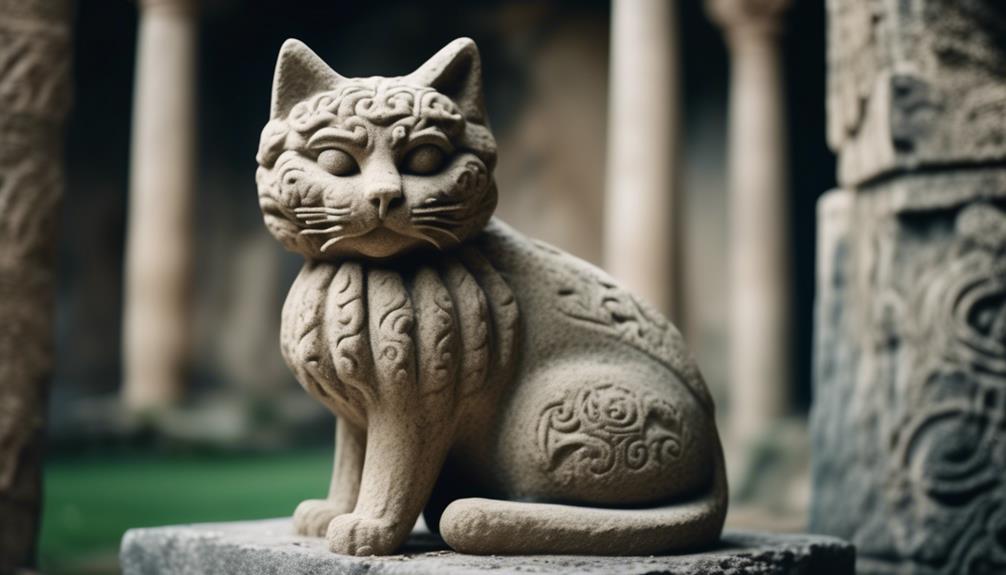
The history of the Cymric breed can be traced back to its origins on the Isle of Man, where it was specifically bred to be tail-free due to a natural genetic mutation intensified by the remote location.
The Isle of Man’s isolation allowed the breeders to concentrate and perpetuate this unique trait.
The name ‘Cymric’ is derived from the Welsh word for ‘Welshman’ and reflects the breed’s connection to the Celtic heritage of the Isle of Man.
The Cymric breed was later brought to Canada, gaining recognition and popularity.
Today, the Cymric is known for its lack of tail or short tail, which doesn’t hinder its agility or hunting skills.
Its history is a testament to the adaptability and resilience of this unique breed.
Adoption Considerations

Continuing our exploration of the Cymric breed, it is important to consider various factors when contemplating adoption.
Here are some key considerations to keep in mind:
- Prioritize adopting from rescue organizations or shelters: By rescuing a Cymric, you provide a loving home and help reduce the number of cats in need.
- Conduct thorough research to choose a reputable breeder: Look for breeders who prioritize the health and temperament of their cats and discourage unethical breeding practices.
- Conduct necessary health screenings: Ensure that the breeder or shelter has conducted health screenings to minimize the risk of genetic health problems.
- Discourage unethical breeding practices: Avoid supporting breeders who prioritize physical appearance over the well-being of the cats.
Care and Health Tips
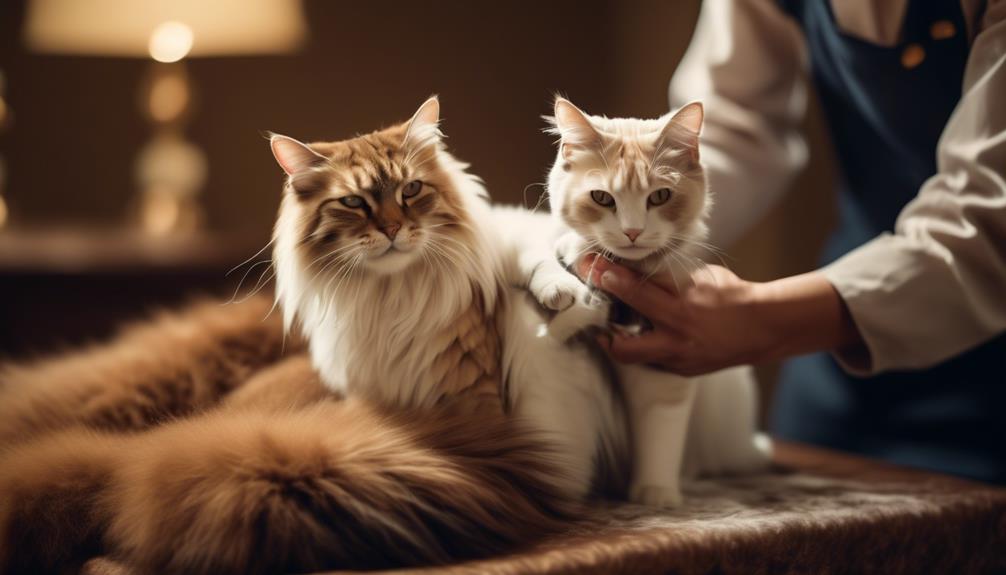
When considering the care and health of Cymric cats, it is important to prioritize regular grooming and hygiene practices.
The Cymric’s long, dense, double-layered coat requires regular brushing or combing to prevent matting and tangling.
Additionally, it is crucial to check and clean their rear end to prevent faeces from clinging to their fur.
Maintaining good oral hygiene is also essential, so brushing their teeth regularly is recommended.
In addition, wiping the corners of their eyes helps to keep them clean.
Regularly checking and cleaning their ears is important to prevent infections.
It is advisable to keep the litter box spotlessly clean and consider an indoor-only lifestyle for your Cymric.
Although they lack a tail or have a short tail, their round head with large round eyes, stout and powerful bodies, and long, soft, silky double coats in various colours are distinctive features of this breed.
Frequently Asked Questions
Are Cymric Cats More Prone to Developing Arthritis Compared to Other Cat Breeds?
Cymric cats, like any other breed, may be prone to developing arthritis.
However, it’s important to note that the incidence of arthritis in Cymric cats is not necessarily higher than other cat breeds.
Regular veterinary care and proper nutrition can help manage and prevent arthritis in cats.
How Often Should a Cymric Cat’s Teeth Be Brushed for Proper Hygiene?
Regular brushing of a Cymric cat’s teeth is essential for proper hygiene.
The frequency of brushing should be at least 2-3 times a week, but daily brushing is ideal to prevent dental issues and maintain good oral health.
Can Cymric Cats Be Trained to Perform Tricks or Commands?
Yes, Cymric cats can be trained to perform tricks or commands.
They are intelligent and eager to please. With patience, positive reinforcement, and consistent training, they can learn various tricks and commands.
Do Cymric Cats Have a Higher Risk of Developing Vision Problems Compared to Other Breeds?
Cymric cats have a higher risk of developing vision problems than other breeds. Incidences of corneal dystrophy affecting vision have been reported.
Regular veterinary check-ups and proper eye care can help maintain their visual health.
Are Cymric Cats Suitable for Households With Small Children?
Cymric cats can be suitable for households with small children due to their affectionate nature and playful personality.
However, it is important to supervise interactions and teach children how to handle cats gently.
Conclusion
In conclusion, the Cymric cat is a unique and captivating breed known for its lack of tail or short tail, playful nature, and affectionate temperament.
Originating from the Isle of Man and later bred in Canada, this medium-sized cat with a stunning long, dense, double-layered coat forms strong bonds with its family members.
With fine hunting skills and alert nature, the Cymric makes an excellent watch.
Care and health considerations are important for this fascinating feline.




